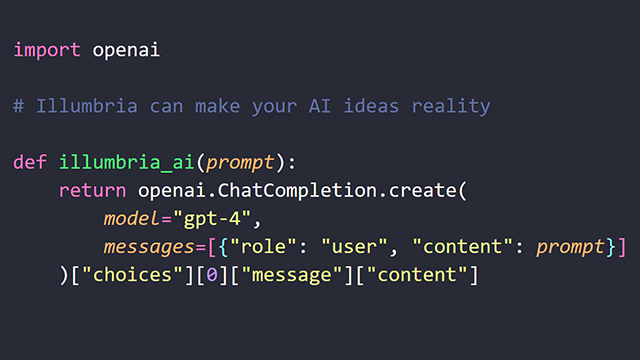At Illumbria, we're often asked what goes into building custom AI solutions that deliver real business value. While the field of artificial intelligence has become more accessible than ever, creating truly effective, production-ready AI systems remains a complex undertaking that requires both technical expertise and strategic vision. In this article, we'll pull back the curtain on our process for developing custom AI solutions, with a particular focus on how we tailor Large Language Models (LLMs) to address specific business challenges.
The Illumbria Approach: Beyond Off-the-Shelf AI
While general-purpose AI models like GPT-4, Claude, and others offer impressive capabilities out of the box, they're rarely optimized for specific business contexts. Our approach focuses on bridging this gap—taking powerful foundation models and transforming them into specialized tools that understand your business domain, integrate with your existing systems, and deliver measurable value.
Here's a look at our end-to-end process for building custom AI solutions:
Our Process
- Discovery & Problem Definition We begin by deeply understanding your business context, challenges, and objectives. This phase involves stakeholder interviews, process analysis, and data assessment to identify high-value AI opportunities.
- Solution Architecture We design a comprehensive solution architecture that addresses your specific needs, considering factors like model selection, data flows, integration points, and scalability requirements.
- Data Strategy & Preparation We develop a data strategy that identifies what information is needed to train, fine-tune, and operate your AI solution, then prepare this data through collection, cleaning, and structuring processes.
- Model Selection & Customization We select the most appropriate foundation models and customize them through techniques like fine-tuning, prompt engineering, and retrieval-augmented generation to align with your specific use case.
- Integration & Development We build the surrounding infrastructure and integrate the AI solution with your existing systems, developing APIs, user interfaces, and workflows that make the AI capabilities accessible and useful.
- Testing & Validation We rigorously test the solution against real-world scenarios, validating its performance, reliability, and alignment with business objectives through both automated testing and user feedback.
- Deployment & Monitoring We deploy the solution to production environments with appropriate monitoring systems that track performance, usage patterns, and potential drift, enabling continuous improvement.
This structured approach ensures that we deliver AI solutions that not only leverage cutting-edge technology but also integrate seamlessly with your business operations and deliver measurable value.
Tailoring LLMs for Specific Business Domains
One of the most powerful aspects of our work involves customizing Large Language Models to understand and operate within specific business domains. Here's a closer look at the techniques we use:
Domain-Specific Fine-Tuning
While foundation models like GPT-4 have broad knowledge, they often lack deep understanding of specialized domains. We use fine-tuning to adapt these models to specific industries, company terminology, and business processes.
For example, when working with a healthcare provider, we fine-tuned a foundation model on medical literature, clinical guidelines, and the organization's own documentation. This resulted in a model that could accurately discuss medical concepts, understand clinical workflows, and generate content that adhered to healthcare compliance requirements.
Fine-Tuning vs. Prompt Engineering
We often get asked about the difference between fine-tuning and prompt engineering, and when to use each approach:
- Fine-tuning involves additional training of the model on domain-specific data, which modifies the model's weights and creates a specialized version. This is ideal for deep domain adaptation or when consistent, specialized behavior is required.
- Prompt engineering involves crafting effective instructions that guide the model's behavior without changing its weights. This is more flexible and faster to implement but may be less consistent for complex domain tasks.
In practice, we often use a combination of both approaches, fine-tuning for core domain understanding and prompt engineering for task-specific guidance.
Retrieval-Augmented Generation (RAG)
One of the most effective techniques in our toolkit is Retrieval-Augmented Generation (RAG), which combines the reasoning capabilities of LLMs with access to external knowledge bases. This approach allows us to create AI systems that can reference your organization's proprietary information when generating responses.
Here's a simplified view of how we implement RAG systems:
# Simplified RAG implementation example
from langchain.embeddings import OpenAIEmbeddings
from langchain.vectorstores import Chroma
from langchain.text_splitter import RecursiveCharacterTextSplitter
from langchain.chains import RetrievalQA
from langchain.llms import OpenAI
# 1. Process and index company documents
def create_knowledge_base(documents):
# Split documents into chunks
text_splitter = RecursiveCharacterTextSplitter(
chunk_size=1000,
chunk_overlap=200
)
texts = text_splitter.split_documents(documents)
# Create vector embeddings and store them
embeddings = OpenAIEmbeddings()
vectorstore = Chroma.from_documents(texts, embeddings)
return vectorstore
# 2. Create a retrieval-based QA system
def create_rag_system(knowledge_base):
retriever = knowledge_base.as_retriever(
search_type="similarity",
search_kwargs={"k": 5}
)
llm = OpenAI(temperature=0)
qa_chain = RetrievalQA.from_chain_type(
llm=llm,
chain_type="stuff",
retriever=retriever,
return_source_documents=True
)
return qa_chain
# 3. Query the system with business questions
def query_system(qa_chain, query):
result = qa_chain({"query": query})
return {
"answer": result["result"],
"sources": [doc.page_content for doc in result["source_documents"]]
}
This approach allows us to create AI systems that combine the general capabilities of LLMs with specific knowledge from your organization, resulting in more accurate, relevant, and trustworthy outputs.
Custom Evaluation Frameworks
A critical aspect of our development process is creating domain-specific evaluation frameworks that assess how well the AI system performs on tasks relevant to your business. These frameworks go beyond generic metrics like perplexity or BLEU scores to measure real-world utility.
For a financial services client, we developed an evaluation framework that assessed the model's outputs across several dimensions:
- Factual accuracy when discussing financial products and regulations
- Compliance adherence to ensure outputs met regulatory requirements
- Clarity of explanation for complex financial concepts
- Personalization quality when tailoring advice to different customer segments
This evaluation framework guided our iterative improvement process, ensuring that the final solution met the specific needs of the financial services context.
Real-World Example: Building a Contract Analysis System
To illustrate our approach in action, let's look at how we developed a custom contract analysis system for a legal services firm. This project demonstrates the full lifecycle of custom AI development, from problem definition to deployment.
Challenge
The client, a mid-sized legal services firm, was spending thousands of attorney hours manually reviewing contracts for due diligence and compliance purposes. They needed a solution that could:
- Automatically identify key clauses and provisions across diverse contract types
- Extract critical information like parties, dates, obligations, and termination conditions
- Flag potential risks and non-standard terms
- Integrate with their existing document management system
Solution Development
Our approach to this challenge involved several key components:
- Data Collection and Preparation: We worked with the client to collect a diverse set of contracts that represented their typical workload, ensuring appropriate data security and confidentiality measures. These contracts were anonymized, cleaned, and structured for model training.
- Model Selection and Fine-Tuning: We selected a foundation model with strong text understanding capabilities and fine-tuned it on legal documents, with particular emphasis on contract language and structure.
- Knowledge Base Creation: We built a specialized knowledge base containing legal definitions, standard clauses, and regulatory requirements relevant to the client's practice areas.
- Custom Extraction Pipeline: We developed a specialized pipeline that could identify and extract key contract elements, using a combination of LLM capabilities and structured extraction techniques.
- Risk Assessment Module: We created a module that evaluated extracted contract elements against the client's risk criteria, flagging potential issues for attorney review.
- Integration Layer: We built APIs and connectors that integrated the system with the client's document management platform, enabling seamless workflow incorporation.
Results
The deployed system delivered significant business impact:
- 70% reduction in time spent on initial contract review
- 85% accuracy in identifying key contract provisions
- 92% of high-risk clauses correctly flagged for attorney attention
- $1.2M annual cost savings through improved attorney efficiency
- Ability to handle 3x the contract volume without additional staffing
Importantly, the system didn't replace attorneys—it augmented their capabilities by handling routine extraction and analysis tasks, allowing them to focus on higher-value strategic and interpretive work.
"The custom AI solution developed by Illumbria has transformed how we approach contract review. What used to take days now takes hours, and our attorneys can focus on the complex legal analysis where they add the most value. The system continues to improve as it processes more contracts, making it an invaluable asset to our practice."
— Managing Partner, Legal Services Client
Key Considerations for Custom AI Development
Based on our experience developing custom AI solutions across industries, we've identified several critical factors that determine project success:
Clear Problem Definition
The most successful AI projects start with a clearly defined business problem rather than a technology-first approach. Understanding exactly what challenges you're trying to solve and what success looks like is essential for effective solution design.
Data Quality and Availability
The quality, quantity, and relevance of available data significantly impact what's possible with custom AI solutions. We work closely with clients to assess their data landscape early in the process and develop strategies to address any gaps or quality issues.
Integration Strategy
Even the most sophisticated AI model delivers limited value if it doesn't integrate smoothly with existing systems and workflows. We prioritize integration planning from the beginning, ensuring that the solution fits naturally into your operational environment.
Ethical Considerations
Custom AI development requires careful attention to ethical implications, including bias mitigation, transparency, privacy protection, and appropriate human oversight. We build these considerations into every stage of our development process.
Continuous Improvement
AI solutions aren't "set and forget" systems—they require ongoing monitoring, evaluation, and refinement. We design our solutions with feedback loops and monitoring systems that enable continuous improvement over time.
Conclusion: The Future of Custom AI Solutions
As AI technologies continue to advance at a rapid pace, the opportunities for custom AI solutions that address specific business challenges will only grow. The organizations that gain the most value from these technologies will be those that approach AI development strategically, focusing on clear business outcomes rather than technology for its own sake.
At Illumbria, we're committed to helping our clients navigate this evolving landscape, combining deep technical expertise with strategic business understanding to create AI solutions that deliver measurable value. Whether you're just beginning to explore AI possibilities or looking to enhance existing implementations, our team is ready to help you transform business challenges into AI-powered opportunities.


